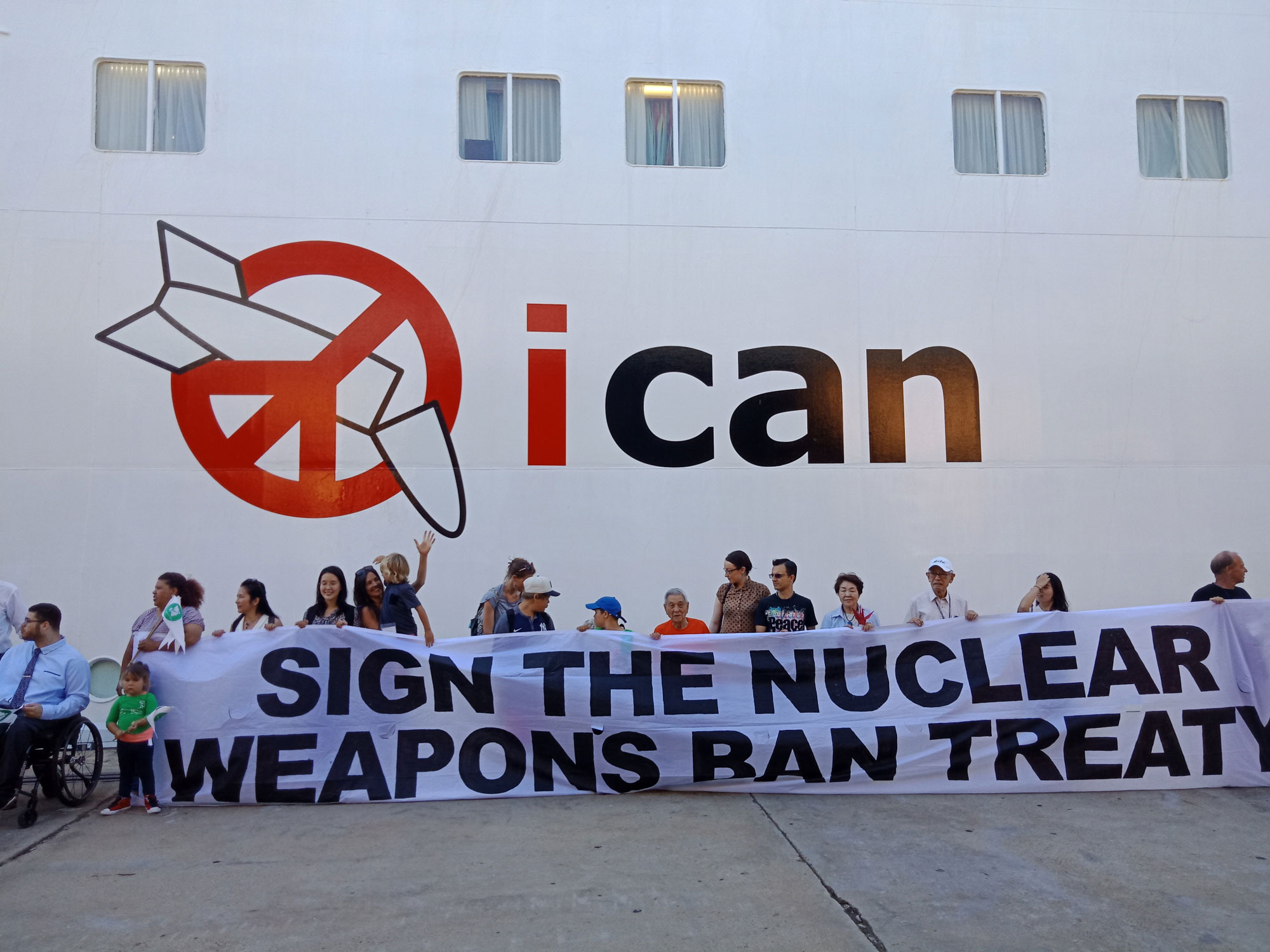Active participation Defining Moments

- Year level 8
- Investigations 1
- Activities 4
- Curriculum topic Active participation
1. Overview of the learning module
Introduction
This learning module provides resources and classroom activities for teachers to use in their Australian Curriculum — Civics and Citizenship Year 8 classrooms.
It supports the Civics and Citizenship knowledge and understanding requirements for aspects of Australia’s government and democracy:
- the freedoms that enable active participation in Australia’s democracy within the bounds of law
- how citizens can participate in Australia’s democracy.
It does this by providing an engaging and interactive way for students to explore how citizens have used the rights and freedoms available in our democracy to bring about change. Topics covered in the module include a hypothetical situation, the historical cases involving the proposed Franklin Dam in Tasmania and the International Campaign to Abolish Nuclear Weapons (ICAN).
The investigation provides a rich digital resource for classroom use. It includes contextual information, documents, images, scaffolded comprehension, analytical and extension questions, and individual, group and class activities. Using these materials and activities, students can explore aspects of the Year 8 knowledge and skills outcomes specified in the Australian Curriculum — Civics and Citizenship.
The learning module has been designed to draw on the National Museum of Australia’s Defining Moments in Australian History, together with some supplementary resources. Students do not need to visit that site to complete this learning module as the featured Defining Moments information used is available on this site.
Module snapshot
The learning module contains:
Students respond to a plan to change a hypothetical local area. Teachers could substitute a real local place for Dingo Reserve to make the activity more real and immediate for students.
Having started to think about realistic and effective actions, students investigate the case of Tasmania’s Franklin Dam. They identify a range of actions that were taken, and recognise the underlying freedoms within the Australian democratic system that make such actions possible. The Franklin issue raises difficult questions about actions that break the law. Teachers will need to decide to what extent they pursue these issues with students.
This activity introduces students to the idea of participating in democracy on a global scale through an investigation of ICAN, an Australian-based international organisation that is seeking to outlaw the use of nuclear weapons.
In this reflection activity students consider the recent school strikes for climate as a further example of active participation in Australia’s democracy.
2. Student activities
Student activities
Setting the scene
Investigation 1: How can you have an influence in society?
Bringing it together
3. Relevant Defining Moments in Australian History
The Defining Moments that are relevant to the different inquiry questions in the curriculum are:
|
1982 |
Investigation 1 |
|
|
2017 |
‘Working to safeguard the future’ — Campaign to abolish nuclear weapons wins Nobel Prize |
Investigation 1 |
Longer versions of the Defining Moments are available on the National Museum of Australia website.
|
1982 |
Protests against Franklin Dam in Tasmania lead to formation of the Greens |
Investigation 1 |
|
2017 |
International Campaign to Abolish Nuclear Weapons (ICAN) wins Nobel Peace Prize |
Investigation 1 |
4. Australian curriculum level and focus
Knowledge and understanding
- The freedoms that enable active participation in Australia’s democracy within the bounds of law (ACHCK061)
- How citizens can participate in Australia’s democracy (ACHCK062)
Inquiry and skills
Students will have exercised a number of these learning skills:
Questioning
- Develop appropriate questions to guide an inquiry about people, events, developments, places, systems and challenges (ACHASSI094)
Researching
- Locate and collect relevant information and data from primary sources and secondary sources (ACHASSI095)
Analysing
- Examine primary sources and secondary sources to determine their origin and purpose (ACHASSI098)
- Examine different viewpoints on actions, events, issues and phenomena in the past and present (ACHASSI099)
Evaluating and reflecting
- Evaluate evidence to draw conclusions (ACHASSI101)
- Work in groups to generate responses to issues and challenges (ACHASSI102)
- Reflect on learning to propose personal and/or collective action in response to an issue or challenge, and predict the probable effects (ACHASSI104)
Interdisciplinary thinking
Students will have engaged with several of the concepts of:
- significance
- continuity and change
- cause and effect
- place and space
- interconnections
- roles, rights and responsibilities
- perspectives and action.
Cross-curriculum priorities
Students will have been involved in additional learning about some aspects of:
- Aboriginal and Torres Strait Islander societies
- Asia and the Pacific
- sustainability.
Source: The Australian Curriculum Humanities and Social Sciences, v8.3, December 2016, accessed 1 February 2019
5. Civics and citizenship outcomes matrix
All case studies in the learning module have been designed to help students develop a number of the knowledge and skills outcomes specified in Australian Curriculum — Civics and Citizenship. At the end of each section teachers could use this matrix to help guide student discussion about what they have achieved. The matrix is suitable to be used from Years 5–10, but with teachers guiding the discussion as appropriate to the particular class. It could also be used for assessment purposes.
|
Outcome |
Elaboration or explanation |
Applying this to each case study |
|---|---|---|
|
KNOWING |
Knowing the key factual elements of government and democracy, laws and citizens, and citizenship, diversity and identity. |
Do you know what the key facts are? |
|
UNDERSTANDING |
Being able to explain how and why these operate in the way they do. |
Do you understand how systems work? |
|
QUESTIONING |
Asking questions that reveal knowledge and understanding. |
Have you asked about all the aspects you need to know? |
|
RESEARCHING |
Locating relevant information. |
Are you gathering the best, most accurate and balanced information and arguments? |
|
ANALYSING |
Critically assessing information and ideas. |
Are you testing to detect bias, propaganda, inaccuracy and incompleteness? |
|
SYNTHESISING |
Bringing information together into a coherent whole. |
Are you reorganising information in a thorough, logical and clear way? |
|
INTERPRETING |
Developing your own findings. |
Are you putting forward your own ideas and acknowledging different perspectives and values? |
|
PROBLEM-SOLVING |
Using information to reach a conclusion. |
Are you using all available information to reach a solution? |
|
DECISION-MAKING |
Choosing between different possibilities. |
Have you explored all the strengths and weaknesses of options and reached the best possible decision? |
|
COMMUNICATING |
Presenting information and ideas clearly and well. |
Is your presentation clear, logical, concise and persuasive? |
|
REFLECTING |
Applying knowledge to understand the present and possible futures of society. |
Are you applying your knowledge and understanding in a way that explains the characteristics of the present situation and takes account of possible changes? |
6. Learning at the National Museum of Australia
Enjoying our online teaching resources? Why not check out what else we have to offer?
We run onsite school programs, digital excursions and teacher professional learning programs.
Discover more about defining moments in Australian history through these curriculum-linked learning activities.









